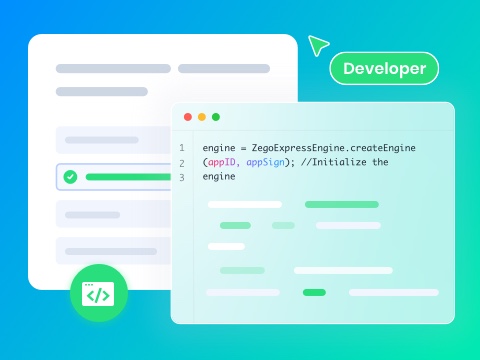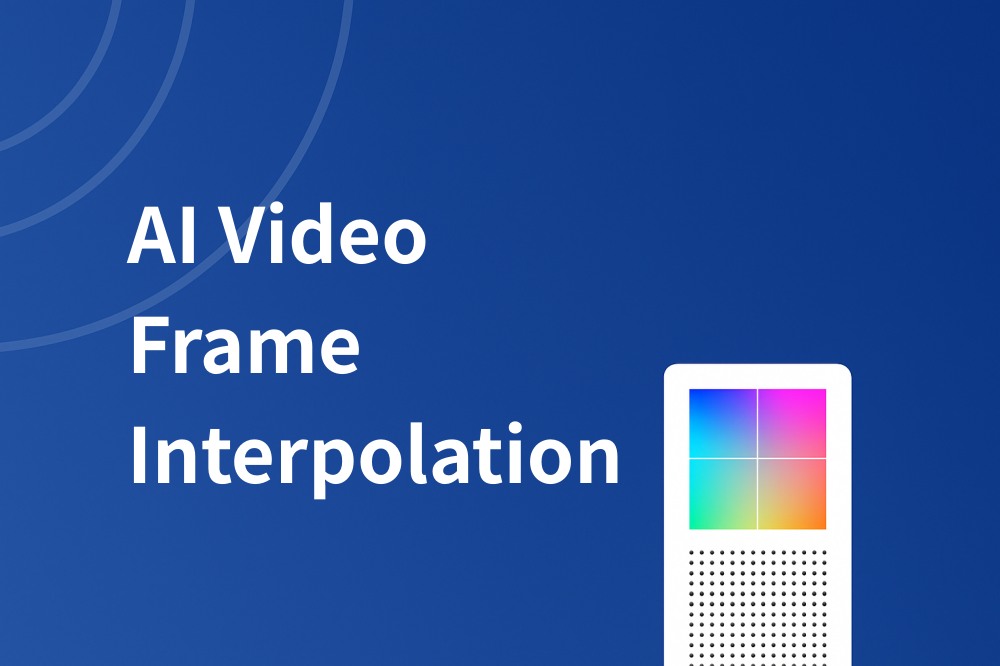As demand for smoother video playback continues to rise, AI video frame interpolation is gaining attention across industries. By generating extra frames using artificial intelligence, this technology delivers fluid motion, clearer visuals, and improved viewing experiences. In this article, we explore how AI frame interpolation works, its practical use cases, and how developers can apply it in real-world applications.
What is AI Video Frame Interpolation?
AI Video Frame Interpolation is a technique that uses artificial intelligence to generate intermediate frames between two existing frames. This results in smoother, more natural-looking video playback. Compared to traditional methods that rely on basic motion estimation, AI approaches are more accurate, especially when dealing with complex motion or low frame rate footage.
By predicting what a frame should look like between two existing ones, AI interpolation enhances the overall visual experience in everything from casual video playback to professional editing and live streaming scenarios.
Why Use AI Instead of Traditional Frame Interpolation?
Traditional frame interpolation techniques, such as optical flow, have been used for many years. While effective in many standard cases, these methods often struggle with fast motion, occlusions, and unusual patterns. Artifacts like ghosting or jitter are common.
AI-based frame interpolation offers significant advantages. Deep learning models are trained on large datasets, which helps them understand object shapes, depth, and movement in a more advanced way. This leads to higher-quality results that are consistent and free from common visual distortions.
These improvements make AI a better fit for modern video applications, particularly those involving dynamic scenes or real-time content.
How AI Video Frame Interpolation Works
AI interpolation works by analyzing two consecutive frames and predicting what an intermediate frame would look like. Instead of relying on simple pixel movement, the AI model learns how objects are expected to move and transform over time.
Here’s a simplified explanation of the process:
- Input frames
The system takes two original frames as input—typically labeled as Frame A and Frame B. - Motion analysis
The AI model analyzes motion patterns, object boundaries, and depth cues between the two frames. - Frame generation
Based on this analysis, it creates one or more realistic intermediate frames that represent the expected motion between A and B. - Frame insertion
The generated frames are inserted between the originals, effectively increasing the frame rate and producing smoother playback.
This approach is widely used in both offline editing tools and real-time streaming systems. Advanced models such as RIFE and DAIN have shown that deep learning can deliver significantly better results than traditional interpolation techniques, especially in scenes with complex motion or low frame rates.
Use Cases for AI Frame Interpolation
AI Video Frame Interpolation is finding its way into a wide range of real-world applications. By generating smoother transitions between frames, it significantly improves the quality and realism of video content across different industries.
1. Slow-Motion Video Creation
Traditional slow-motion effects often lead to stuttering or ghosting, especially when there are not enough frames captured. With AI interpolation, standard footage can be transformed into high-quality slow motion by creating additional intermediate frames. This makes it ideal for cinematic content, sports replays, or product demos that require smooth and dramatic motion.
2. Live Streaming Enhancements
Live streaming, especially in fast-moving contexts like esports, fitness classes, or live concerts, suffers from motion blur or low frame rate under poor bandwidth. AI-powered live frame interpolation improves perceived smoothness by intelligently filling in transitional frames in real time, resulting in a more immersive experience for viewers.
3. Video Repair and Restoration
In film restoration and archival projects, frames may be damaged, dropped, or missing entirely. AI interpolation tools can help reconstruct these frames with context-aware predictions, preserving historical footage and enhancing old videos without manual frame-by-frame editing.
4. Animation and Anime Fluidity
Animations, particularly traditional 2D anime, are often produced at low frame rates to save cost. AI frame interpolation increases the frame count, making character movements and action scenes more fluid. This has led to improved viewing experiences in remastered content and fan-made high-frame anime versions.
5. Mobile and Online Video Editors
A growing number of frame interpolation online platforms now offer AI-powered features for casual creators. These tools allow users to upload a video and enhance its frame rate without installing software. Thanks to the availability of AI frame interpolation online free services, more independent creators, educators, and influencers can access this technology with minimal barriers.
Best Tools for AI Frame Interpolation
Several tools and frameworks are available for implementing AI-based frame interpolation, whether online or locally:
- RIFE (Real-Time Intermediate Flow Estimation): Well-known for its speed and quality in real-time scenarios.
- DAIN (Depth-Aware Interpolation): Offers strong results for slow-motion and cinematic footage.
- Flowframes: A desktop application that provides GPU-accelerated frame generation with a user-friendly interface.
- Online solutions: Some platforms offer AI frame interpolation online for free, allowing users to upload their videos and receive interpolated results without needing to install software.
These tools serve both hobbyists and professionals, helping to bring AI-quality video enhancement to a broader audience.
ZEGOCLOUD + AI Frame Interpolation: Smarter Live Streaming
For developers building live video platforms, delivering smooth and high-quality playback is essential. ZEGOCLOUD offers low-latency video infrastructure that enables seamless integration with AI-powered technologies like frame interpolation.
By combining ZEGOCLOUD with AI interpolation models, developers can achieve real-time frame enhancement during live sessions. This is especially valuable in use cases such as video chat, virtual classrooms, and live sports streaming, where motion clarity directly impacts user experience.
With cross-platform UIkits and easy-to-integrate SDKs, ZEGOCLOUD allows teams to build advanced video features faster. Developers enjoy reduced complexity, while users benefit from visually smoother, more immersive live content.
The Future of AI Video Frame Interpolation
The field of AI Video Frame Interpolation is evolving quickly. What once required powerful desktop software is now becoming feasible on mobile devices and even within browsers. As edge computing advances and AI models become more efficient, this technology is expected to integrate more deeply into real-time systems.
In the near future, we may see frame interpolation available directly on smartphones and AR/VR headsets, enabling smoother motion across immersive experiences. Streaming platforms are also likely to adopt interpolation as a native feature, improving playback quality without requiring user-side adjustments. Additionally, frame generation will become smarter and more adaptive, responding dynamically to different content types or viewer preferences.
Access to AI interpolation will also expand through cloud-based APIs and SDKs, making it easier for developers to implement high-quality video enhancement in their products. As expectations for video quality continue to grow, AI frame interpolation is positioned to become a standard component in content delivery—from individual creators using free online tools, to businesses optimizing real-time communication. This technology will play a central role in shaping the future of digital video experiences.
Conclusion
AI video frame interpolation is reshaping how we create, view, and enhance video content. From smoother playback to intelligent motion prediction, it unlocks new levels of quality across live and on-demand applications. As the technology continues to advance, it will become a key component in everything from entertainment to real-time communication. Whether you’re building video tools or looking to enhance visual experiences, now is the right time to explore what AI-powered frame interpolation can offer.
FAQ
Q1. What are the best AI frame interpolation programs right now?
Some of the most popular AI frame interpolation programs include:
- RIFE (Real-Time Intermediate Flow Estimation): Known for fast and accurate real-time results
- DAIN (Depth-Aware Interpolation): Great for detailed cinematic and slow-motion effects
- Flowframes: A user-friendly desktop app that leverages GPU power for quick processing
- Butterflow & SVP: Useful for converting standard videos into higher frame rates
Q2. Can AI frame interpolation be used in live streaming?
Yes. With the right infrastructure, such as ZEGOCLOUD’s low-latency streaming SDKs, developers can implement real-time frame interpolation for live video. This can greatly improve the smoothness of fast-paced events like sports or webinars.
Q3. Are there any free AI frame interpolation tools available online?
Yes, several platforms offer AI frame interpolation online free tools where users can upload their videos and get high-frame-rate results without installing software. These are great for quick edits or testing the technology before integrating it into larger workflows.
Let’s Build APP Together
Start building with real-time video, voice & chat SDK for apps today!










